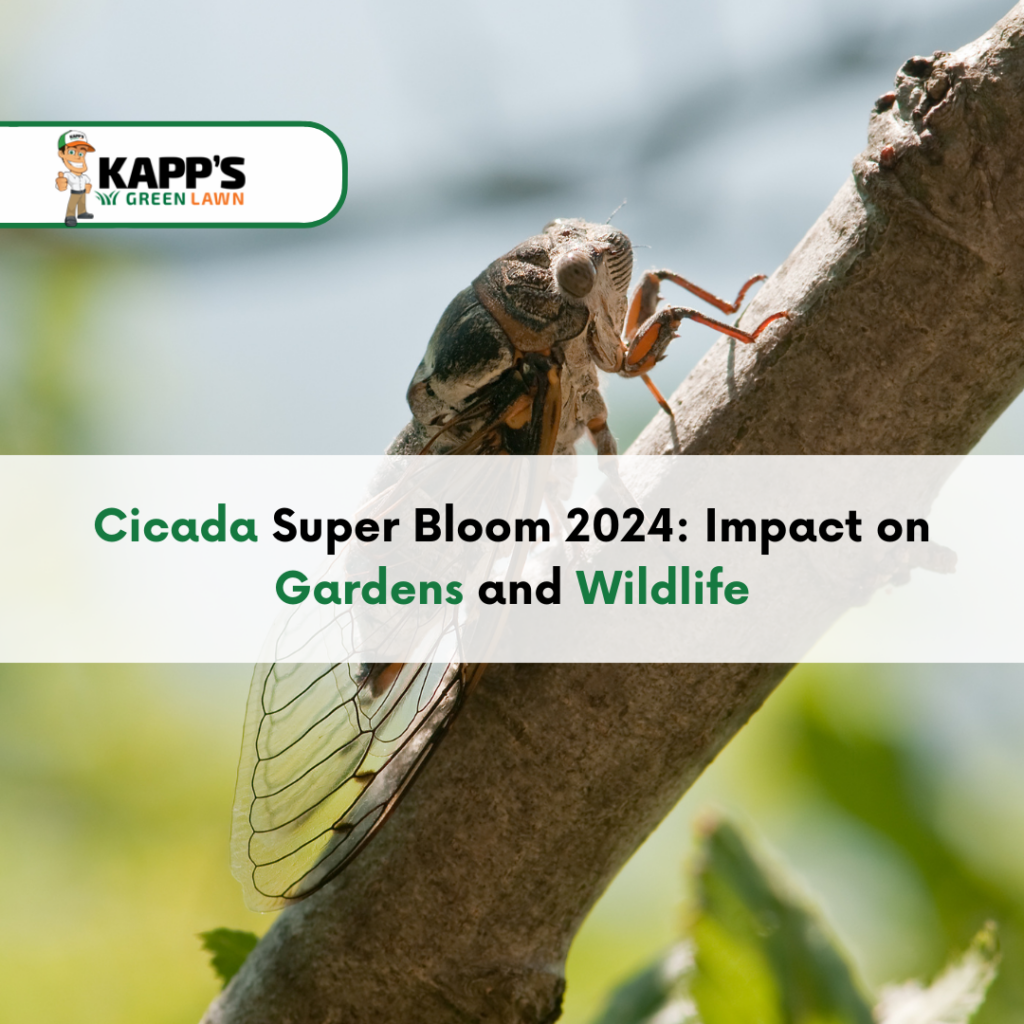
How Cicadas Affect Wildlife and Ecosystems in Your Garden
Every 200 years, a rare and fascinating event occurs in the Eastern half of the United States: the Cicada Super Bloom. In 2024, we’re on the brink of experiencing this unique phenomenon once more. It’s when two different cycles of cicadas, those on 13-year and 17-year life spans, emerge from the ground at the same time. This isn’t just a marvel of nature; it’s a loud, somewhat messy, but ultimately incredible occasion that affects our local ecosystems in various ways.
Here at Kapp's Green Lawn Care, we understand the importance of preparing for such events. While cicadas might be known for their overwhelming noise and the weirdness of their vast numbers, they play a crucial role in our ecological system. They aerate the soil, provide food for predators, and return nutrients to the earth as they perish. This natural process offers both challenges and opportunities for homeowners and garden enthusiasts.
As we delve into the fascinating world of cicadas and their impact on your garden, we'll share practical advice on how you can manage and possibly even benefit from this upcoming Cicada Super Bloom. Whether it’s protecting young trees or adjusting your landscaping practices for the season, we’re here to help ensure your garden remains thriving and healthy through this and any natural event.
What Is the Cicada Super Bloom 2024?
Every 200 years, an extraordinary event happens in the Eastern half of the country called the Cicada Super Bloom. This is when not one, but two groups of cicadas, known as broods, come up from the ground at the same time. These cicadas have been waiting under our feet for either 13 or 17 years!
The Cicada Super Bloom is important because it is so rare. This event covers many states, affecting vast forests and countless gardens. Knowing that such a massive swarm of cicadas is on its way may sound a bit scary, but it’s a fascinating natural occurrence that has significant effects on our environment.
How Cicadas Influence Soil and Plant Health
Cicadas play a sneaky, but crucial role in keeping our gardens healthy. When these noisy critters come to visit, they do more than just buzz around. They help the soil in your garden become better. As they move and dig underground, cicadas make tiny tunnels that allow air to flow through the soil. This aeration helps water, and nutrients move better around the roots of plants.
Moreover, when cicadas finish their above-ground life, they return to the earth and decompose. This process adds important nutrients back into the soil, acting almost like a natural fertilizer. While we can't stop these insects from arriving, we make sure your trees and shrubs are well taken care of during this period.
For instance, keeping your garden’s plant health up to par helps ensure that your green friends are resilient enough to handle the temporary hustle and bustle of the cicada super bloom. By maintaining strong and healthy plants, we indirectly assist them in dealing with any stress caused by our loud little visitors.
Wildlife Reactions to the Cicada Emergence
As we witness the remarkable event of the Cicada Super Bloom, it's fascinating to note how local wildlife is influenced. Numerous animals, such as birds, small mammals, fish, and even other insects, enjoy feasting on cicadas. These critters aren't just munching on cicadas because they're there; these insects serve as a high-protein snack that many animals rely on, especially since they emerge in such overwhelming numbers.
The availability of cicadas as a food source leads to a temporary spike in local wildlife activity. Predators that eat cicadas might have more offspring because there's more food available, leading to a short-term boost in their populations.
This bountiful period helps sustain the food chain in our local ecosystems, as increased predator numbers can keep other potentially disruptive insect populations under control. In this way, the Cicada Super Bloom contributes to balancing our natural surroundings.
Tips for Managing Your Garden During a Cicada Bloom
When cicadas invade, they're not subtle. These noisy neighbors can cause a bit of a stir in your beloved gardens. However, there are several ways to minimize their impact. A simple yet effective method is to wrap the trunks of young trees with garden netting or a similar material. This prevents cicadas from climbing up and laying eggs in the branches, which can cause small twigs to weaken or split.
Adjusting your garden care is also wise during a Cicada Bloom. Delay planting new trees or undertaking large landscaping projects until after the cicadas have gone. This ensures that your new plants won't be overwhelmed by cicadas as soon as they're planted. Even though cicadas don't pose a severe threat to well-established trees, the young ones can be vulnerable.
The Buzz About Cicadas: How These Noisy Insects Impact Your Garden
As the Cicada Super Bloom 2024 approaches, it’s an excellent time for us to appreciate and prepare for the unique changes it brings to our local environment. Although the noise might be overwhelming at times, this natural phenomenon enriches our soil, supports our wildlife, and brings a burst of activity to our ecosystems, demonstrating nature’s incredible interconnectedness.
At Kapp's Green Lawn Care, we’re here to help ensure that your gardens not only endure but thrive during this and similar natural events. By providing expert care and practical advice, like proper tree wrapping techniques and optimal timing for planting, we help safeguard the health and beauty of your local landscapes.
If you’re seeking tree and shrub care, feel free to reach out. Let’s work together to turn this natural challenge into a flourishing opportunity for your garden.
